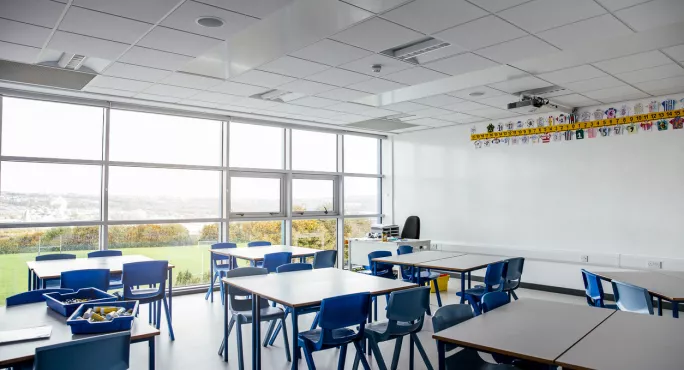Revealed: How the second lockdown widened learning loss

Primary school pupils were more than three months behind in maths and two months behind in reading after the second national Covid lockdown, new analysis shows.
By June in the summer term primary pupils’ learning loss remained “substantial” but had recovered to 2.2 months in maths and 0.9 months in reading.
Background: UK pupils lost third of learning time during pandemic
Analysis: Will schools take the hit for Sir Kevan’s departure?
News: Catch-up effort ‘a bit feeble’, says Sir Kevan Collins
The data also shows that secondary school students did not recover as much as pupils in primary schools.
In reading, secondary students saw losses of 1.5 months of learning by the autumn term (2020), but by the summer term (2021), losses were still 1.2 months.
How Covid has hit disadvantaged pupils
The Department for Education published new research today on the extent of learning loss among pupils in England during the summer and spring terms after the Covid pandemic led to schools moving to remote learning for most pupils.
The research is comprised of two new DfE reports, one examining pupil learning loss during the spring term 2021, and another covering pupil learning loss during the more recent summer term 2021.
Key findings include:
- By the spring term, there was evidence that learning loss was higher in maths than in reading.
- By the spring term, the gap in learning loss between disadvantaged pupils and their more affluent peers in maths remained at around a month for primary-aged pupils.
- By the spring term, the disadvantage gap in reading had widened by around 6 per cent for primary-aged pupils and around 7 per cent for secondary-aged students since before the pandemic.
- Data shows a regional disparity in the level of learning loss as a result of the Covid pandemic, with the parts of the North hardest hit in both reading in maths.
- The greatest losses in reading were in the North East and in Yorkshire and the Humber, for both primary and secondary, where pupils in these regions experienced greater learning loss than the average for all primary and secondary-aged pupils.
- In maths it was again pupils in the North East and Yorkshire and the Humber who experienced the greatest learning losses, along with those in the East and West Midlands.
Learning loss refers to the months of learning pupils are behind following the pandemic, compared to a typical, pre-pandemic school year.
Geoff Barton, general secretary of the Association of School and College Leaders, said: “This research provides further evidence of the scale of learning loss experienced by pupils as a result of the Covid pandemic, and, in particular, the impact on disadvantaged pupils, who have clearly suffered the most.
“Government funding for education recovery to help pupils catch up is welcome, including the announcements in Wednesday’s Budget, but does not go far enough in terms of scale or ambition.
“These children have suffered the greatest educational disruption since the Second World War and they need and deserve a far better recovery package.”
Dr Mary Bousted, joint general secretary of the NEU teaching union, said: “Teachers worked hard for all their pupils throughout the pandemic and the needs of the disadvantaged is of paramount importance to school and college leaders and their staff.
“Throughout summer term 2021 we called on government to get a grip on Covid, but instead they allowed both the virus and absence rates to spiral.
“This inevitably has an impact on young people’s learning, and it is in the less affluent parts of the country - and in crowded homes - where Covid transmission is more likely to be higher.
“The government’s recipe for autumn has been not only more of the same but even fewer mitigations. Their corner-cutting on education recovery, which persists in this week’s Budget, makes it abundantly clear that the prime minister’s commitment to ‘repaying’ the generation of school pupils affected by the Covid pandemic is just words.
“If this really was his priority, he would have insisted that education recovery was given the funding it needs rather than being short-changed by billions of pounds.”
A Department for Education spokesperson said: “It’s encouraging to see pupils beginning to close the gaps that opened up over the past 18 months, but we know there is still more to do - in particular, for disadvantaged pupils.
“That’s why this week we announced a further £1.8 billion dedicated to supporting young people to recover from the impact of the pandemic, including a £1 billion recovery fund for schools and more time in education for 16- to 19-year-olds, taking total funding dedicated to young people’s recovery to almost £5 billion.
“This additional investment - on top of the £1.6 billion increase in core funding for schools next year and the £4.7 billion total increase up to 2024-25 - builds on the planned delivery of 6 million tutoring courses and world-class training for hundreds of thousands of teachers, and shows the government’s continued ambition in making sure every young person can get back on track following the disruption of the pandemic.”
The data comes after chancellor Rishi Sunak announced an extra £1 billion of Covid catch up funding for schools in his spending review announcement earlier this week.
You need a Tes subscription to read this article
Subscribe now to read this article and get other subscriber-only content:
- Unlimited access to all Tes magazine content
- Exclusive subscriber-only stories
- Award-winning email newsletters
Already a subscriber? Log in
You need a subscription to read this article
Subscribe now to read this article and get other subscriber-only content, including:
- Unlimited access to all Tes magazine content
- Exclusive subscriber-only stories
- Award-winning email newsletters
topics in this article



